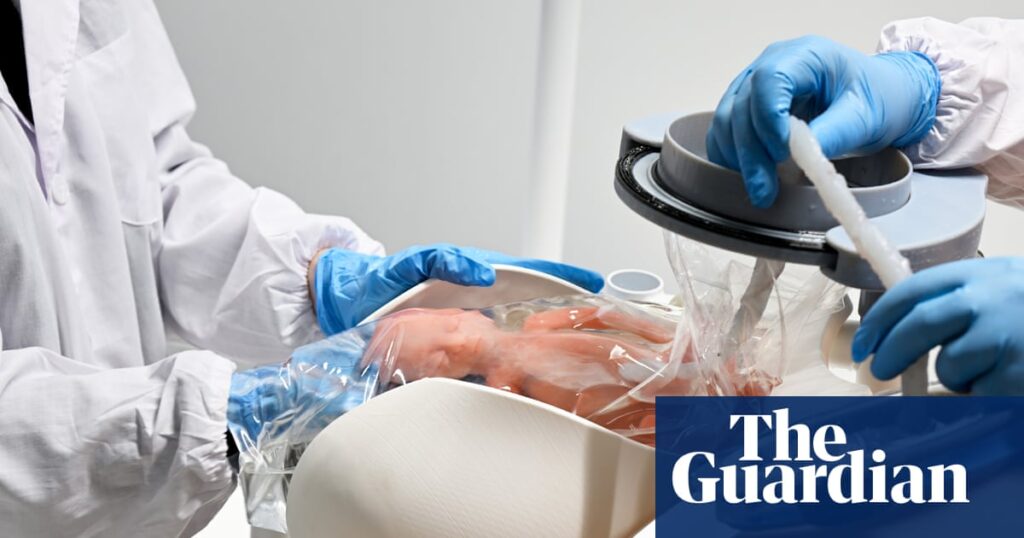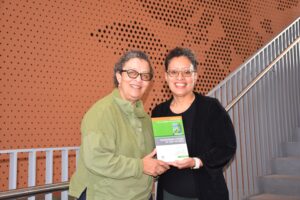
Beth Schafer lay in a hospital bed, bracing for the birth of her son. The first contractions rippled through her body before she felt remotely ready. She knew, with a mother’s pit-of-the-stomach intuition, that her baby was not ready either. At just 23 weeks of gestation, her son teetered on the cliff edge of viability, the fragile threshold where modern medicine offers any promise of keeping babies alive.
Beth’s son did not – could not – cry when he was born. The instant his entire body, small enough to cradle in a single palm, landed in the delivering doctor’s latexed hand, a swarm of blue scrubs closed in to begin resuscitation. But despite their fervent attempts to triage, to coax air into his tiny, caved-in lungs, they could not supply what Beth’s son needed most: more time in the womb.
Scientists worldwide are racing to buy more time for extremely premature babies like Beth’s. In 2017, researchers in Philadelphia unveiled an experimental lifeline: an artificial womb, engineered to gestate babies outside the human body. In their study’s photos, fetal lambs floated inside what looked like overgrown Ziploc bags, eyes closed and hearts pumping as if they had never left their mothers. That prototype was only tested on animals, but the technology is edging closer to human use.
The Race to Develop Artificial Wombs
In September 2023, the United States Food and Drug Administration convened an advisory committee to consider whether to greenlight the first clinical trials. If approved, the first candidates will be babies like Beth’s son, those born between 22 and 24 weeks of gestation, or less than two-thirds of the way to full term. FDA representatives declined to comment on whether or when these trials might begin.
In the US, more than 10,000 infants are born each year within these precarious boundaries. Premature birth remains the nation’s second-leading cause of infant death, and even those who survive may face crippling complications, from chronic lung disease to lifelong neurological damage. Artificial wombs promise to change that trajectory, saving more babies and sparing more parents from grief. But growing a child outside the body also cuts to the core of how people imagine pregnancy and parenthood.
“This kind of device would create a new stage of human development, something we’ve never had to describe or regulate before,” says Elizabeth Chloe Romanis, a medical law scholar at Durham University.
The announcement comes as scientists, bioethicists, and legal experts scramble to address the myriad questions that arise before human trials begin: how will this technology affect the ways we intervene in preserving life, or how we define life itself?
Inside the Artificial Womb
When I first see the prototype, I don’t think of a womb. I think of an aquarium. The glass tank rests on a waist-high platform in a bright laboratory in Aachen, Germany, one of the sites affiliated with AquaWomb, a Dutch startup that is developing devices to improve health outcomes for the smallest, sickest infants.
About the size of a household fishtank, the vessel sits under fluorescent lights so technicians can monitor every movement inside, though in practice it would be covered to mimic the dimness of the womb. Tubes coil from the sides into filters that cycle synthetic amniotic fluid in rhythmic glugs.
Myrthe van der Ven, a technical physician and the co-founder and CEO of AquaWomb, shows me how their prototype mimics the constant shelter of pregnancy. The amniotic fluid holds at 99.7F, just above a mother’s core temperature. A double-layered bag hangs in the tank’s center. Its inner sac flexes as the baby grows, from pomegranate-sized at 23 weeks to the heft of an eggplant by 28. The outer silicone layer is stiffer, with just enough give to resist the baby’s kicks and encourage its muscles to stretch and strengthen.
The tank, van der Ven tells me, is the simple part. The lungs are the true liability. During a typical birth, a newborn’s first gulp of air triggers the breathing reflex, often announced with a wail that signals lungs at work. That moment comes too early for extremely premature infants: their runty lungs can’t sustain even a whisper, much less nourish the developing brain and body.
Artificial wombs aim to bypass this crisis altogether. In AquaWomb’s design, the baby is delivered via caesarean section into a fluid-filled pouch, where it can be transferred from mother to machine. Once inside the transfer chamber, clinicians reattach the umbilical cord to a human-made placenta, a fist-sized device lined with catheters delicate enough to pull carbon dioxide from the blood and cannulas robust enough to push oxygen and nutrients in.
“It’s like juggling 10 balls,” says Frans van de Vosse, a professor in cardiovascular biomechanics at Eindhoven University of Technology who advises the project. “Only the balls are on fire and dropping one is not an option.”
Ethical and Emotional Considerations
If perfected, an artificial womb could rewrite the limits of viability. Perhaps this is why the handful of labs working on these machines hesitate even to name them. AquaWomb describes its prototype as a “womb-like life support system”. They are wary of the political and science-fiction associations attached to the term “artificial womb”.
Meanwhile, the entire field operates under a veil of secrecy. CHOP representatives declined to comment for this story. Vitara Biomedical, the private company that licensed CHOP’s artificial womb technology, has raised more than $125m, a sign they might be preparing for clinical trials. Some researchers told me CHOP scientists have agreed to collaboration meetings, then backed out.
The guardedness reflects both the scrutiny surrounding reproductive technology and the knowledge that, as van der Ven puts it, “in science, there’s evolutionary and there’s revolutionary”. An artificial womb would be the latter.
Her team is not trying to win the race at all costs. “We don’t need to be the first. We want to be the best,” she says. For her, that means designing a system where parents can interact with their gestating babies, a priority she feels other researchers have overlooked. One AquaWomb prototype includes access ports that let parents touch their infants. Another features a “uterus phone”, which pipes voices, music or heartbeats into the fluid at the same muffled pitch a fetus would hear in the womb.
Those parent-child interactions – pressing a fingertip against a foot, speaking into the fluid, feeling a shift inside the bag – could improve long-term health outcomes for premature infants. But the stakes of parental bonding during pregnancy go beyond survival statistics.
“They may not feel they’ve fulfilled their ‘duty’ to protect and carry their child,” says Romanis. She argues that any ethical alternative to “natural” pregnancy must address parents’ emotional needs alongside infants’ physiological ones.
In other words, seeing your baby suspended in a tank or sealed in a bag could alter not only how you connect with them, but how you see yourself as a parent.
Three months after losing her son, Beth joined a biweekly support group for parents who have experienced late-term pregnancy loss or whose newborns died soon after birth, often because of extreme prematurity. Attenders discuss what to do with unopened baby gifts or how to deflect well-meaning questions from relatives and co-workers. Many are parents of children who might have been prime candidates for an artificial womb.
When Beth invites me to join her, I picture a lecture hall or hospital conference room. Instead, we arrive at the basement of a Boston church, where Wendy, a therapist who leads the group, arranges a circle of folding chairs. Attenders trickle in.
Only one of today’s 17 attenders is a man. (He and his husband lost their daughter when their surrogate miscarried late in pregnancy.) Across from me sits a girl who looks too young to order a drink at the bar, let alone to have already had and buried a baby. Her peroxide blond hair brushes the salt-and-pepper nest of Joanne, who is nearly 60 and has been attending for three years, having joined the group over a decade after losing her son. The group also includes an English professor, stay-at-home mom, police officer and pediatric nurse.
In this circle, I see how pregnancy loss is unequally borne, but grief is indiscriminate.
“We tried making a Facebook group once,” Beth tells me, “But it got overtaken by anti-vaxxers asking if we’d had the Covid vaccine.”
Wendy lays a hand on Joanne’s wrist and winks at me. “As you can see, we’re very open here. You can ask us about your baby bags.”
“Biobags”, I utter through hiccupy laughs, unprepared for their nonchalance. I explain that the technology is still several years from hospitals, and even then, would probably be offered only to infants born at 22 or 23 weeks, who have paltry alternatives.
“I lost my baby at 22 weeks,” Joanne interrupts. “Are you saying this could have saved him?”
“Maybe,” I admit. “But not necessarily. Hypothetically, if your doctors thought he was a candidate for an artificial womb, would you have …”
“Absolutely,” Joanne insists. “All I wanted was to save him. If my body couldn’t do that, then maybe this womb thing could.”
The parents crave more morsels of information to feed their hypotheticals: Could my baby have survived at 21 weeks? How much would it cost? Would I be able to see my daughter? Hold her?
Two women grimace when I describe the prototypes, but the others lean forward and ask for photographs. They picture their children in an artificial womb, submerged in the soothing embrace of synthetic dreams.
These parents do not know exactly what the technology could have given them, but it is agonizingly clear that they understand what they have lost without it. Most have not disassembled their babies’ cribs. The pediatric nurse contemplates switching specialties because she cannot be around newborns without wanting to cry. And Beth often clutches her belly as she speaks, like she is cradling a child who is no longer there.
Each parent is haunted by what could have been done differently. Most cling to the idea that more intervention, more technology, might have saved their babies.
“Is more always better?” Wendy hesitates. She recounts delivering her daughter via C-section at 24 weeks and begging her doctors to administer aggressive care. Despite the precarious birth, the doctors saved Wendy’s baby in the operating room, compressing her chest to churn blood to her brain. For four months in the Nicu (Neonatal Intensive Care Unit), her daughter lived tethered to lines and flushed with drugs. These were costly, painful procedures. But her stunted lungs needed more time to mature.
Wendy needed more time, too. “The prognosis was bad, but when it comes to your kid, you can’t help but keep praying for a miracle. I couldn’t let her go.”
After 131 days, her daughter died from a collapsed lung. For months, Wendy was racked with guilt, hot and salty grief leaking down her face. “I felt so selfish,” she says. “Even though I eventually let go of those feelings, I wish I’d given her a more peaceful, less prolonged end.”
Although she supports the development of artificial wombs, Wendy wonders how doctors will obtain informed consent from parents who are desperate to save their babies. “Maybe there is a future world where every parent can access this technology,” she says. “How will they know whether it’s the right decision? For the baby, or for them.”
“I can’t stop looking at the photos of the lambs in the baggies,” Beth tells me, a week after my first visit to her support group. “Probably should stop doing it right before lunch.”
The footage of CHOP’s animal trials unsettled her, not only the sight of slick pink bodies drifting in fluid, but also its eerie resemblance to a scene from The Matrix, where human infants are farmed in industrial pods.
For decades, scientists and science-fiction writers alike have been chasing the stork. In 1958, a Swedish team tried to sustain seven “pre-viable” human fetuses in what was essentially a pressure-cooker incubator with a pump to oxygenate blood. Their test lasted only a few hours, and modern ethics boards would recoil at the crude attempt to create an artificial womb. Still, what had once been a thought experiment briefly took on flesh.
Today’s artificial womb prototypes are neither capable of nor designed to supplant natural pregnancy. Nonetheless, when CHOP published its research on biobags, it birthed a stream of sensational speculations around “complete ectogenesis”, where fertilization to birth occurs entirely outside a woman’s uterus.
Researchers have tried to tamp down those associations, positioning their work as a giant leap forward for science but an unremarkable tiptoe for parenthood.
“The concept of complete ectogenesis is so far away that it’s not worth talking about in relation to the current work,” says one scientist working on artificial wombs. “Premature babies die every day, and this technology could save at least some of them. If you want to sit around debating The Matrix, you’re missing the point.”
Other experts believe these concerns can’t be brushed aside.
“There is no such thing as ‘not worth talking about’ when it comes to procreative futures. Science fiction and science fact aren’t so far divorced when it comes to thinking about what might be a problem,” Romanis says.
She adds that, even in its earliest form, an artificial womb would confront parents with agonizing choices. This makes me think about Wendy, who wondered how a parent, driven by the desperate hope of saving their child, could understand the implications of placing their baby in a highly experimental device.
On this point, such clinicians such as Christoph Haller, a cardiovascular surgeon in Toronto, describe artificial wombs as an opportunity for continuity rather than rupture. His team is testing their own prototype on fetal pigs. “The conversations with parents won’t be entirely new,” he says. “We already have to ask them to make impossible decisions: do we intubate, do we operate, do we stop? With any new technology, we’ll keep being honest about what we know and what we don’t.”
But no one writes dystopian novels about IV drips or ventilators. With artificial wombs, the fantasy – and the fear – are built in.
That becomes clear when I return to the grief group a month after my first visit. Beth again raises the lamb photos. Joanne nods quickly. “I keep looking at them too. If that bag had been around, maybe I wouldn’t be sitting here. I’d have signed anything to get another few weeks.”
Across the circle, a younger woman shakes her head sharply. “That’s just it. You wouldn’t have had a choice. They’d cram your baby in whether you wanted them to or not.” She won’t say who they are – politicians, doctors, hospitals – but the suspicion hangs heavy. “People already treat you like you’re selfish if you don’t do every single intervention. This would be one more thing they’d hold over you.”
The man who lost his daughter during surrogacy clears his throat. “I can’t help wondering, would my husband and I even have used a surrogate if something like this had been available? Maybe the right thing would be to avoid putting another person at risk by asking them to carry a pregnancy.”
The room vibrates with competing anxieties: that the technology will not arrive soon enough, and







